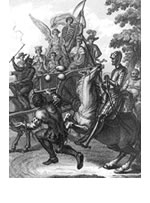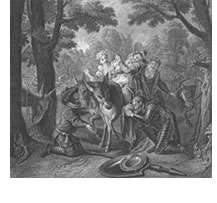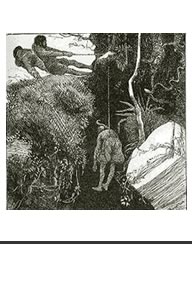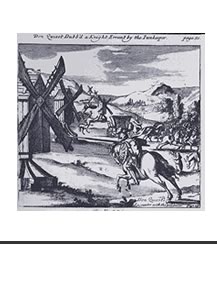SUMMARY OF THE NARRATIVE BY JOHN VERNON LORD
The Story (A synopsis of the plot) Titlepage of the first illustrated
edition Brussels, 1662
Book 1
A fifty year old `lean bodied' and `thin faced' rural gentleman called
Alonso Quijano lives in a modest household with his niece and a housemaid
in a country village in La Mancha in Spain. He becomes obsessed with books
of chivalry, selling many acres of cornfield to purchase the volumes.
`From little sleep and too much reading his brain dried up and he lost
his wits'. `He had a fancy ... to turn knight errant and travel through
the world with horse and armour in search of adventures' with the purpose
of `redressing all manner of wrongs'. He found some old rusty armour and
mounted his old hack horse to seek adventures; calling himself `Don Quixote
de La Mancha' and his nag - `Rocinante'. In the chivalric tradition of
knight's being enamoured of some lady or other, Don Quixote chose the
name of `Dulcinea del Tobosa' (who was called after a farm girl - Aldonza
Lorenzo - who he had been taken with at one time). And so (`for the benefit
of the distressed, according to the obligations of knighthood') Don Quixote
went on his first expedition and `took whatever road his horse chose,
in the belief that in this lay the essence of adventure'. He is knighted
by the landlord of an inn , believing him to be a Lord of a castle. He
keeps vigil over his armour which he places on a water trough in the courtyard
of the inn. He injures a group of carriers when they watered their mules.
After only three days of adventure Don Quixote is beaten up by a servant
belonging to travelling silk merchants whom the knight had unsuccessfully
attacked when they had refused to acknowledge Dulcinea as the most beautiful
maiden in the world. he is rescued by a neighbour and carried home on
the back of a donkey. At home his housekeeper, a priest and barber burn
all Don Quixote's library of books on chivalry and try to dissuade him
from going on more quests. Don Quixote persuades his neighbour Sancho
Panza, a plump labourer, to join him as his squire on his second expedition,
promising him the governorship of an island if he joined him.
After about fifteen days at home Don Quixote and Sancho Panza depart secretly
at night for the next expedition; Sancho mounted upon his ass - Dapple.
The second sally lasts just three weeks and takes up almost the rest of
Part 1 of the book. They meet with many adventures: the battle with the
windmills, which Don Quixote confuses for giants; a lady on her way to
Seville in a carriage; a party of Benedictine monks riding mules; adventures
in inns - when Maritornes, the maid, goes mistakenly to DQ's bed; when
DQ & SP refuse to pay their bill Sancho is tossed in a blanket; a
battle with a flock of sheep which DQ believes to be Alonfanfaron's mighty
army; Sancho christens Don Quixote as `the Knight of the Sad Countenance';
a chained gang of prisoners being taken to a port to become galley slaves;
the rural constabulary going about their business; a canon of Toledo; a
religious procession carrying an image of the Virgin; an itinerant barber,
who protects his head with his barber's basin which the Don confuses to
be Mambrino's helmet; a funeral party escorting a body by night on a bier
etc.
Knight and squire are continually being beaten up in the course of these
adventures and there are a series of other moral tales (belonging to the
pastoral story-telling tradition) interpolated within the main plot. One
of these stories (about the lovers `Cardenio and Dorotea; Bk. 1,Ch. 23
ff.) weaves itself in an out of the main narrative for much of Part 1.
There are also two monologues delivered by the knight: one (Bk. 1,Ch.
11) is a learned description of the Golden Age of mythology, told during
a supper shared with some goatherds who understood not a word he said;
the other, later on in the book (Bk. 1,Ch. 37-8) when he addresses a company
during dinner at an inn in a debate about whether the career of arms is
superior to that of letters, or vice versa. The knight's fellow diners
eat throughout his speech and none of them follow up what he has to say.
We also have a discussion, towards the end of the book (Bk. 1,Ch. 47-8),
between a canon and a priest about fiction and chivalric romances which
hints at Cervantes' theory of fiction.
The first book ends with the knight's humiliating return home, imprisoned
in a cage on an ox-cart by his village priest and barber for Don Quixote's
own good.
Book 2
Don Quixote now sets his heart upon going to a jousting tournament in
Saragossa. In the second book we are soon introduced to a young man from
DQ's village - Sansón Carrasco a recent graduate of Salamanca University.
He takes on the earlier roles of the priest and the barber in attempting
to rescue and keep Don Quixote away from danger. Sanson tells DQ & SP
the news that their deeds have been published in a book. Knight and Squire
take to the road again in Chapter 7 of the second book. DQ is determined
to go to Tobosa to pay his respects to Dulcinea. They encounter three
peasant girls and by some deception, Sancho hopes that his master will
accept one of these as being Dulcinea. DQ believes that the enchanters
have made her look like an ugly peasant girl.
Don Quixote unexpectedly wins a battle with another knight (The Knight
of the Mirrors), who turns out to be none other than Sansón Carrasco
in disguise. Sansón had hoped to get the Don back home to safety
by disguising himself as a rival knight errant but the plan didn't work.
Shortly afterwards DQ & SP meet the `Knight in the Green Topcoat'
(Don Diego de Miranda) which includes the episode of the lion which the
Don wants to do battle with, to no avail. Chapters 19-22 are devoted
to the pastoral tale, `Camacho's Wedding' in which knight and squire
play parts in. Then follows the adventure of Don Quixote's descent into
the Cave of Montesinos, after which, in a trance, he tells of the marvellous
things he experienced while down there. At a wayside inn Sancho and Don
Quixote attend Master Peter's puppet show. DQ gets carried away by the
spectacle of the puppet Moorish knights doing battle with Christians
and attacks them with his sword. and smashes everything to bits.
Don Quixote accepts an invitation to the unnamed Duke and Duchess's palace
and park (Chapters 30-58). They have fun at Don Quixote's expense by organising
a series of burlesque pageants and sometimes causing injury to DQ and
SP. They arrange for Sancho to govern the Island of Barataria and are
surprised by the squire's talent for leadership. Much social satire is
prominent in this part of the book. At the beginning of Book Two Don Quixote
was intending to go to a jousting tournament in Saragossa but at Chapter
59 Cervantes must have heard of the appearance, in Autumn 1614, of a bogus
second part of his novel by one called Avellaneda. Cervantes made artistic
use of this occurrence by incorporating it in his own `genuine' novel.
In Chapter 59 when Don Quixote and Sancho Panza are eating supper at an
inn they here comments about this alleged second volume of their life.
The Don is annoyed at Avellaneda for suggesting he has abandoned Dulcinea
and the fact that his long-awaited arrival in Saragossa has already been
described. He is therefore resolved to go to Barcelona instead. In Chapter
72 Cervantes even kidnaps a prominent character (Don Alvaro Tarfe) from
Avellaneda's book.
Don Quixote then gets involved with a bandit by the name of Roque Guinart.
Then the knight and Sancho arrive at Barcelona where they are the guests
of Don Antonio Moreno who also proposed to have fun at the Don's expense,
but less hurtfully so. He is a guest to the squadron of the royal galleys
in the port and is received with full naval honours.
In Chapter 64 the Knight of the White Moon enters the scene while Don
Quixote is exercising his horse on the beach at Barcelona. The Knight
of the White Moon challenges Don Quixote to battle in the presence of
the viceroy and a distinguished company. Don Quixote is soon defeated
by the Knight of the White Moon, who turns out to be none other than Sampson
Carrasco. A condition of his defeat is to abandon knight errantry for
the rest of his life. Sampson's good intentions to save Don Quixote are
not appreciated by the Barcelonians nor Don Antonio Moreno who ticks him
off for spoiling the amusement.
The remaining chapters recount the journey of DQ & SP back to their
village which includes a further stay with the Duke and Duchess (who
make further fun of him) and sundry other humiliating experiences suffered
by the knight.
When they reach home the poorly Don Quixote is put to bed and after a
long sleep declares his name to be Alonso Quijano once more and denounces
chivalry and knighthood. He dies among the lamentation of friends.
note. It is important to read the prologue to Don Quixote where Cervantes
makes a point of drawing us into an obligatory relationship with himself
and his text. titlepage of the Blount edition c1612.Cervantes, the author
of Don Quixote
The first part of Don Quixote was published in 1605 when its Spanish
author Cervantes was 57 years of age. It first came out when Shakespeare
had just finished writing Macbeth; when the Spanish composer - Tomás
Luis de Victoria published his Officium Defunctorum and John Dowland,
in England, published his famous Lachrimae. It was the time when the painters
- Isaac Oliver and Nicholas Hilliard in England were painting their miniatures
in England; when Caravaggio and El Greco were completing their last canvases
in Italy and Spain respectively. Velasquez and Zurbarán were young
lads and Ribera was a teenager. It was also the year when Guy Fawkes
was arrested in the cellars of Parliament in England for his involvement
in the Gunpowder Plot to blow up the House of Lords during James I's
state opening of Parliament. It was a time just before Galileo had made
his first thermometer and invented the microscope. Miguel de Cervantes
Saavedra (1547-1616) had a varied career: he was initially a soldier,
having fought at the Battle of Lepanto where he received serious wounds
including his left hand. In 1575 he was captured and imprisoned in Algiers
for five years and made four daring attempts to escape. He tried to earn
a living as a writer and wrote Galatea, a pastoral romance in 1585, and
some twenty to thirty plays. He was appointed tax collector in 1594 and
three years later was sent to prison for failing to make up the sum due
to the treasury. Tradition has it that Cervantes wrote the first part
of Don Quixote in prison at Argamasilla in La Mancha. In early January
1605 the book came out in Madrid and soon became a success. He completed
the second part of Don Quixote in 1615, just a year before his death.
note. In Don Quixote the Captive's Tale and its conclusion (Cohen's translation
pp 345-380) alludes to Cervantes' own life.
|

































